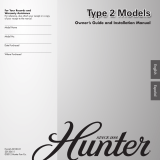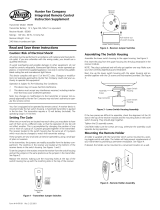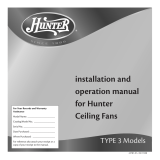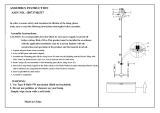Page is loading ...

Type 2 ModelsType 2 ModelsType 2 Models
Form# 42419-01
20081124
©2008 Hunter Fan Co.
For Your Records and
Warranty Assistance
For reference, also attach your receipt or a copy
of your receipt to the manual.
__________________________________________
Model Name
__________________________________________
Model No.
__________________________________________
Date Purchased
__________________________________________
Where Purchased
English
Owner’s Guide and Installation Manual
Español

2
42419-01 • 11/24/08 • Hunter Fan Company
Table of Contents
1 • Getting Ready .................................................4
2 • Installing the Ceiling Plate ....................... 5
3 • Assembling the Fan .....................................6
4 • Hanging and Wiring the Fan ..................7
5 • Installing the Canopy and Canopy
Trim Ring............................................................8
6 • Assembling the Blades ...............................9
7 •
S et t in g th e Rem ote Tra ns mitt er
and Receiver
............................................. 10
8 •
Completing Your Installation ............. 11
9 •
Operating the Remote Control
and Mounting the Holder
............ 14
10 •
Operating and Cleaning Your
Ceiling Fan
.................................................. 15
11 •
Troubleshooting
.................................... 16
© 2008 Hunter Fan Company
Your new Hunter
®
ceiling fan is an addition to your home or oce that
will provide comfort and performance for many years. is installation
and operation manual gives you complete instructions for installing
and operating your fan.
We are proud of our work. We appreciate the opportunity to supply
you with the best ceiling fan available anywhere in the world.
Before installing your fan, for your records and warranty assistance,
record information from the carton and Hunter nameplate label
(located on the top of the fan motor housing).
Cautions and Warnings
• READ THIS ENTIRE MANUAL CAREFULLY BEFORE BEGINNING
INSTALLATION. SAVE THESE INSTRUCTIONS.
• Use only Hunter replacement parts.
• To reduce the risk of personal injury, attach the fan directly to the
support structure of the building according to these instructions,
and use only the hardware supplied.
• To avoid possible electrical shock, before installing your fan,
disconnect the power by turning o the circuit breakers to the
outlet box and associated wall switch location. If you cannot lock
the circuit breakers in the o position, securely fasten a prominent
warning device, such as a tag, to the service panel.
• All wiring must be in accordance with national and local electrical
codes and ANSI/NFPA 70. If you are unfamiliar with wiring, use a
qualied electrician.
• To reduce the risk of personal injury, do not bend the blade
attachment system when installing, balancing, or cleaning the fan.
Never insert foreign objects between rotating fan blades.
• To reduce the risk of re, electrical shock, or motor damage, do not
use a solid-state speed control with this fan. Use only Hunter speed
controls.
Welcome

3
42419-01 • 11/24/08 • Hunter Fan Company
Installer’s Choice and Optional Accessories
Understanding Mounting and Installer’s Choice®
Hunter’s patented 3-position mounting system provides you maximum
installation exibility and ease. You can install your Hunter fan in one
of three ways, depending on ceiling height and your preference: Low
Prole, Standard, or Angled mounting. e steps in this manual include
instructions for all three Installer’s Choice mounting methods.
Considering Optional Accessories
Consider using Hunter’s optional accessories, including a wall-mounted
or remote speed control. To install and use the accessories, follow
the instructions included with each product. For quiet and optimum
performance of your Hunter fan, use only Hunter speed controls.
For ceilings higher than 8 feet, you can purchase
Hunter extension downrods. All Hunter fans use
sturdy 3/4” diameter pipe to assure stability and
wobble-free performance.
Standard Mounting hangs from the
ceiling by a downrod (included).
Angled Mounting recommended for a
vaulted or angled ceiling
Support Brace
Standard
Mounting
Style
Ceiling
Outlet Box
Support Brace
Ceiling
Outlet Box
Angled
Mounting
Style
Low Profile Mounting ts close to the
ceiling, recommended for ceilings less
than 8 feet high
Support Brace
Low Prole
Mounting
Style
Ceiling
Outlet Box
8
12
CAUTION: To
reduce the risk of
personal injury, attach
the fan directly to the
support structure of
the building according
to these instructions,
and use only the
hardware supplied.

4
42419-01 • 11/24/08 • Hunter Fan Company
1 • Getting Ready
To install a ceiling fan, be sure you can do the following:
• Locate the ceiling joist or other suitable support in ceiling.
• Drill holes for and install wood screws.
• Identify and connect electrical wires.
• Lift 40 pounds.
If you need help installing the fan, your Hunter fan dealer can direct
you to a licensed installer or electrician.
Gathering the Tools
You will need the following tools for installing the fan:
• Electric drill with 9/64” bit
• Standard screwdriver (magnetic tip recommended)
• Phillips-head screwdriver (magnetic tip recommended)
• Wrench or pliers
• Ladder (height dependent upon installation site)
Checking Your Fan Parts
Carefully unpack your fan to avoid damage to the fan parts. Refer to
the included Parts Guide. Check for any shipping damage to the motor
or fan blades. If any parts are missing or damaged, contact your Hunter
dealer or call Hunter Technical Support Department at 888-830-1326.
Preparing the Fan Site
Before you begin installing the fan, follow all the instructions in
the pullout sheet called “Preparing the Fan Site.” Proper ceiling fan
location and attachment to the building structure are essential for
safety, reliable operation, maximum eciency, and energy savings.
Installing Multiple Fans?
If you are installing more than
one fan, keep the fan blades and
blade irons (if applicable) in sets,
as they were shipped.

5
42419-01 • 11/24/08 • Hunter Fan Company
2-1. Drill two pilot holes into the wood support structure through the
outermost holes in the outlet box. e pilot holes should be 9/64”
in diameter.
2-2. Your fan comes with two neoprene noise isolators (“Isolators”).
Position the isolators between the ceiling plate and ceiling by
inserting the raised areas on each isolator into the holes in the
ceiling plate.
2-3. read the lead wires from the outlet box down through the hole
in the middle of the ceiling plate.
2-4. Align the slotted holes in the ceiling plate with the pilot holes you
drilled in the wood support structure. For proper alignment use
slotted holes directly across from each other.
Note: e isolators should be ush against the ceiling.
2-5. Place a at washer on each of the two 3” screws and pass the
screws through the slotted holes in the ceiling plate into the pilot
holes you drilled.
Tighten the screws into the 9/64” pilot holes; do not use lubricants
on the screws. Do not over tighten.
Step 2-2
Flat Washer
3” Screw
Steps 2-3 – 2-5
2 • Installing the Ceiling Plate
For Angled Ceilings: Be sure to orient
the ceiling plate so that the two tabs
are pointing toward the ceiling peak.
Ceiling
Plate
Toward
Ceiling Peak

6
42419-01 • 11/24/08 • Hunter Fan Company
3 • Assembling and Hanging the Fan
Step 3-5
Canopy Slots
You can assemble your fan for standard mounting (steps 3-1 – 3-2) or
for low prole mounting (steps 3-3 – 3-4).
3-1. To assemble fan to hang down from a at or angled ceiling, insert
the downrod through the canopy. Feed the wires from the fan
through the downrod.
3-2. Loosen the setscrew on the adapter to install the pipe and ball
assembly. Note: When the pipe and ball assembly is fully installed,
2-3 threads on the pipe will still be visible; this is normal. Securely
retighten the setscrew with a wrench or pliers. Skip to Step 3-5.
CAUTION: e adapter has a special coating on the threads. Do
not remove this coating; the coating prevents the downrod from
unscrewing. Once assembled, do not remove the downrod.
3-3. Place the low prole washer into the canopy. Be sure the green
ground wire is pointing up toward the ceiling.
Note: For low prole mounting, the downrod is replaced with the
low prole washer. See Steps 3-3 – 3-4.
3-4. Align the holes in the washer with the holes in the adapter.
Assemble securely with three #8-32 x 1” screws.
3-5. Raise the fan and align the slots in the canopy with the tabs on the
ceiling plate. Go to 4 • Wiring the Fan.
WARNING: Fan may fall if not assembled as directed in these
installation instructions.
Ceiling
Plate
Tabs
Steps 3-1 – 3-2
Steps 3-3 – 3-4
Low Prole
Washer
Downrod
Canopy
Setscrew
#8-32 x 1” Screw

7
42419-01 • 11/24/08 • Hunter Fan Company
fsdfsdf
4 • Wiring the Fan
All wiring must be in accordance with national and local electrical
codes and ANSI/NFPA 70. If you are unfamiliar with wiring, use a
qualified electrician.
Wall switches are not included. Select an acceptable general-use switch
in accordance with national and local electrical codes.
4-1. Before attempting installation, make sure the power is still o.
4-2. To connect the wires, hold the bare metal leads together and place
a wire connector over them, then twist clockwise until tight. For
all these connections use the wire connectors provided.
4-3. Connect the bare or green ground wire (grounded) from the
ceiling to the green ground wire (grounded) from the ceiling plate
and the green ground wire from the fan.
4-4. Connect the white wire (ungrounded) from the ceiling to the
white wire (ungrounded) from the fan.
4-5. Connect the remaining wires as follows:
Single Switch Wiring:
• e black wire (ungrounded) from the ceiling to the black
(ungrounded) wire from the fan.
CAUTION: Be sure no bare wire or wire strands are visible after
making connections.
4-6. Turn the splices upward and push them carefully back through the
ceiling plate into the outlet box.
4-7. Spread the wires apart, with the grounded wires on one side of
the outlet box and the ungrounded wires on the other side of the
outlet box.
Single Switch Wiring
Wire
Connector

8
42419-01 • 11/24/08 • Hunter Fan Company
5 • Installing the Canopy
5-1. Rotate the hanger ball so the tab in the canopy is secure in the
groove in the hanger ball.
WARNING: Failure to complete this step could cause fan to fall.
5-2. Lift the fan and align the canopy screw holes with the mounting
holes on the ceiling plate.
5-3. Partially install a canopy screw into the side opposite the ceiling
plate tabs.
5-4. Partially install another canopy screw into the hole between the
two ceiling plate tabs. Securely tighten both screws.
5-5. Using both hands, push the canopy trim ring up to the top of the
canopy. e canopy trim ring will snap and lock into place.
Step 5-4
Step 5-1
Step 5-2
Groove
Tab
Step 5-3
Step 5-5
Should you need to remove the canopy
trim ring, follow these steps:
1. Locate the tab indicators, small
bumps on top of tabs.
2. Press rmly on opposite sides of the
ring toward the canopy. e tabs will
ex out releasing the trim ring from
the canopy.

9
42419-01 • 11/24/08 • Hunter Fan Company
6 • Assembling the Blades
Hunter fans use several styles of fan blade irons (brackets that hold the
blade to the fan).
6-1. Your fan may include blade grommets. If your fan has grommets,
insert them by hand into the holes on the blades.
6-2. Attach each blade to a blade iron using three blade assembly
screws. If you used grommets, the blades may appear slightly loose
after screws are tightened. is is normal.
6-3. Remove the blade mounting screws and rubber shipping bumpers
from the motor. Note: Some blade mounting screws are installed
in the motor to secure shipping blocks.
6-4. For each blade, insert one blade mounting screw through the
blade iron, and attach lightly to the fan. Insert the second blade
mounting screw, then securely tighten both mounting screws.
Step 6-1 (Detail)
Blade Assembly
Screws
Use with grommet
Use without grommet
Grommet
Blade
Mounting
Screw
Steps 6-1 – 6-2
Step 6-4

10
42419-01 • 11/24/08 • Hunter Fan Company
CAUTION: e remote control device complies with part 15 of the FCC rules.
Changes or modications not expressly approved by Hunter Fan Company could void
your authority to operate this equipment.
Operation is subject to the following two conditions:
1. is device may not cause harmful interference.
2. is device must accept any interference received, including interference that may
cause undesired operation.
Note: Use with a fan that incorporates an air gap switch (normal on-o wall switch).
WARNING: Maximum fan load is 1 Amp; maximum lamp is 100 Watts. Do not use
any speed control with this product.
You must now set the jumpers in the remote transmitter and receiver
so that they match.
7-1. Change the position of the jumpers in the transmitter and the
receiver. e receiver is located inside the lightkit. Be sure the
position of the jumper in the transmitter matches the position of
the jumper in the receiver. If they don’t match, the controller will
not function.
7-2. Install the included 12-volt battery into the transmitter.
Setting Jumpers
When two or more fans are located near each other, you may desire to
have the receiver/transmitter for each fan set to a dierent code, so that
the operation of one fan does not aect the operation of the other fans.
In the transmitter you can access the jumpers from the battery
compartment. e jumpers are very small. You can move them most
easily using a small pair of pliers or tweezers. IMPORTANT! Before
you change a jumper, make sure the battery is not connected to the
transmitter.
4321
4321
4321
4321
4 = off (apagado)
3 = on (encendido)
2 = on (encendido)
1 = on (encendido)
4 = off (apagado)
3 = on (encendido)
2 = off (apagado)
1 = on (encendido)
Example Jumpers Settings
Receiver 1 Receiver 2
Transmitter 2Transmitter 1
4321
4321
4321
4321
4 = off (apagado)
3 = on (encendido)
2 = on (encendido)
1 = on (encendido)
4 = off (apagado)
3 = on (encendido)
2 =
off (apagado)
1 = on (encendido)
7 • Setting the Remote Transmitter and Receiver

11
42419-01 • 11/24/08 • Hunter Fan Company
Your Hunter fan comes with an integrated light xture assembly and an
optional switch housing cap and plug button. is feature gives you the
option of installing the fan with OR without the included light xture.
e steps below direct you whether or not you are installing a light
xture.
WARNING: Use only the light xture supplied with this fan model.
8-1. To attach the upper switch housing, partially install two housing
assembly screws into the switch housing mounting plate.
8-2. Feed the upper plug connector through the center opening of the
housing.
8-3. Align the keyhole slots in the housing with the housing assembly
screws.
8-4. Turn the housing counterclockwise until the housing assembly
screws are rmly situated in the narrow end of the keyhole slots.
Install the remaining screw into the housing. Tighten all three
screws rmly.
CAUTION: Make sure the upper switch housing is securely
attached to the switch housing mounting plate. Failure to properly
attach and tighten all three assembly screws could result in the
switch housing and light xture falling.
8-5. If you want to install the light xture, proceed with step 8-6
now.
If you do not want to install the light xture, you need to
uninstall it now. See “Uninstalling the Light Fixture” on step 8-11.
Steps 8-1 – 8-3
Housing
Assembly
Screw
Upper
Switch
Housing
8 • Completing Your Installation With or Without a Multi Staked Light Fixture

12
42419-01 • 11/24/08 • Hunter Fan Company
8-6. To attach the lower switch housing, connect the plug connector
from the motor to the plug connector from the receiver in the
lower switch housing assembly.
Note: Both plug connectors are polarized and will only t together
one way. Make sure the connectors are properly aligned before
connecting them. Incorrect connection could cause improper
operation and damage to the product.
8-7. Place the lower switch housing assembly over the upper switch
housing. Align the side screw holes in the upper and lower switch
housings. Attach the lower switch housing to the upper switch
housing with three #6-32 x 1/2” housing assembly screws.
8-8. To install each shade, rst loosen the three thumbscrews.
8-9. Raise the shade to the light xture. Tighten the thumbscrews
securely.
8-10. Install B10 candelabra base light bulbs (60 Watt maximum each).
Note: Glass shade style and number of lights may vary.
Lower Switch
Housing
Plug
Connector
Plug
Connector
Detail
Steps 8-6 – 8-7
Housing
Assembly Screw
8 • Completing Your Installation With or Without a Multi Staked Light Fixture (Cont.)
Steps 8-8 – 8-10
umbscrews
Shade
Bulb
Note: In compliance with US federal energy regulations, this
ceiling fan contains a device that restricts the light kit to a
maximum of 190 Watts. Exceeding that limit or the marked
limit on this product may result in re hazard or improper
operation.

13
42419-01 • 11/24/08 • Hunter Fan Company
Receiver
Plug
Connector
Detail
Steps 8-6 – 8-9
Housing
Assembly Screw
8 • Completing Your Installation With or Without a Multi Staked Light Fixture (Cont.)
8-11. Remove the receiver from the light kit.
8-12. Disconnect the light plug connectors between the black wire
and the black/white wire.
8-13. Disconnect the light plug connectors between the two white
wires.
8-14. Install the dummy terminals (included in the hardware kit) on
the two disconnected wires on the receiver.
8-15. Place the receiver into the alternate switch housing. Making sure
the mounting holes at the top of the switch housing line up
with the matching slots in the top of the receiver.
8-16. Place the lower switch housing assembly over the upper switch
housing. Align the side screw holes in the upper and lower
switch housings. Attach the lower switch housing to the upper
switch housing with three #6-32 x 1/2” housing assembly
screws.
Light
Kit
Light Plug
Connector
Detail
Light Plug
Connectors
Steps 8-10 – 8-11

14
42419-01 • 11/24/08 • Hunter Fan Company
9-1. e remote transmitter has individual buttons for turning the fan
o and on and controlling the light and fan speed.
9-2. For best operation, start the fan by pressing high, then select your
desired speed.
9-3. e light button turns the light on to full brightness. To dim the
light, hold the light button down until you reach your desired
brightness. Push the light button again to turn o the light.
9-4. Press the OFF button to turn the fan o.
9-5. When necessary, replace the battery with a 12-volt type 23A,
MN-21 battery or equivalent.
9-6. You can mount the remote holder to any toggle switch plate with
the screws already in the switch plate. Or, you can simply mount
the remote holder on the wall.
Fan Light
Steps 10-1 – 10-4
Step 10-6
Step 10-5
Fan Speed
High
Fan Speed
Medium
Fan Speed
Low
Fan O
Fan Reverse
9 • Operating the Remote Control and Mounting the Holder

15
42419-01 • 11/24/08 • Hunter Fan Company
10 • Operating and Cleaning Your Ceiling Fan
In warm weather, use
downward air ow pattern
In cold weather, use upward
air ow pattern
10-1. Turn on electrical power to the fan.
10-2. e fan pull chain controls power to the fan. e pull chain has
four settings in sequence: High, Medium, Low and O.
• Pull the chain slowly to change settings.
• Release slowly to prevent the chain from recoiling into the
blades.
• e chain uses a breakaway connector that separates if the
chain is jerked. If this happens, simply reinsert the chain into
the connector.
10-3. e light pull chain controls the power to the light xture. e
chain has two settings: ON and OFF.
10-4. Ceiling fans work best by blowing air downward (counterclockwise
blade rotation) in warm weather to cool the room with a direct
breeze. In winter, having the fan draw air upward (clockwise blade
rotation) will distribute the warmer air trapped at the ceiling
around the room without causing a draft.
10-5. For cleaning nishes, use a soft brush or lint-free cloth to prevent
scratching. A vacuum cleaner brush nozzle can remove heavier
dust. Remove surface smudges or accumulated dirt and dust using
a mild detergent and a slightly dampened cloth. You may use
an artistic agent, but never abrasive cleaning agents as they will
damage the nish.
10-6. Clean wood nish blades with a furniture polishing cloth.
Occasionally, apply a light coat of furniture polish for added
protection and beauty. Clean painted and high-gloss blades in the
same manner as the fan nish.
To Change Airow Direction
Turn the fan o and let it come to a complete
stop. Slide the reversing switch on the fan to the
opposite position. Restart fan.
Reversing
Switch

16
42419-01 • 11/24/08 • Hunter Fan Company
Problem: Nothing happens; fan does not move.
1. Turn power on, replace fuse, or reset breaker.
2. Loosen canopy, check all connections according to the wiring the
fan section.
3. Check the plug connection in the switch housing.
4. Push motor reversing switch rmly left or right to ensure that the
switch is engaged.
5. Pull the pull chain to ensure it is on.
6. Remove the shipping bumpers.
Problem: Noisy operation.
1. Tighten the blade assembly screws and blade iron armature screws
until snug.
2. Check to see if the blade is cracked. If so, replace all the blades.
Problem: Excessive wobbling.
1. If your fan wobbles when operating, use the enclosed balancing kit
and instructions to balance the fan.
2. Tighten all blade iron screws.
3. Turn power o, support fan very carefully, and check that the
hanger ball is properly seated.
Problem: Lights dim when turned on or do not turn on
1. Check to make sure the wattage and type of light bulbs installed
match the specications on the light socket.
If you need parts or service assistance, please call
888-830-1326 or visit us at our Web site at
http://www.hunterfan.com.
Hunter Fan Company
2500 Frisco Avenue
Memphis, Tennessee 38114
11 • Troubleshooting
/











